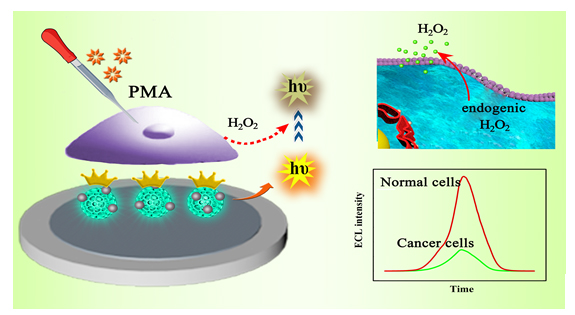摘要/Abstract

本工作借助金属-有机框架(MOF)结构, 通过配位作用实现对电化学发光(ECL)分子的空间有序组装, 获得了高性能ECL新材料, 发展了孔道限域效应和微纳空间ECL分子有序组装的协同增强ECL新策略. 具体而言, 以非共平面ECL分子1,1,2,2-四(4-羧基苯)乙烯(H4TCPE)为配体采用一步水热法合成了具有优异ECL性能的新型MOF材料(Zr-TCPE). Zr-TCPE通过将发光配体H4TCPE固定在MOF多孔材料上, 一方面其多孔结构可以促进限域空间内物质和电子的传递, 加快电化学反应的效率; 同时, MOF结构的配位键合作用限制了发光基团的自由转动与振动以及分子间的紧密堆积, 从而有效减少了非辐射弛豫和内滤效应. 和H4TCPE的微纳晶体相比, Zr-TCPE的ECL强度提高了3.46倍, ECL效率提高了17.44倍. 采用Zr-TCPE构建了ECL生物传感平台, 成功实现了在药物刺激下肿瘤细胞释放过氧化氢(H2O2)的原位监测, 对临床检测肿瘤细胞具有指导意义.
关键词: 金属-有机框架材料, 1,1,2,2-四(4-羧基苯)乙烯, 电化学发光生物传感器, 肿瘤细胞, 过氧化氢
In this work, a kind of high-performance electrochemiluminescence (ECL) material was obtained with the assistant of metal-organic framework (MOF) structure, which realized the highly ordered assembly of ECL molecules in MOF structure, developing a new strategy of synergistically enhanced ECL. Specifically, it combined the advantages of both the pore confinement effect and the highly ordered assembly of ECL molecules in micro/nano space to enhance the ECL intensity and reaction efficiency. The proposed MOF material (abbreviated as Zr-TCPE) with excellent ECL performance was synthesized by a simple solvothermal synthesis technique employing the non-coplanar molecule 1,1,2,2-tetrachlorophenol- (4-carboxylic benzene)ethylene (H4TCPE) as ligand and Zr6 clusters through coordination interaction. Zr-TCPE with the porous structure can not only promote the mass transport and electron transfer in the confined micro/nano spaces, but also reduce the nonradiative relaxation and filtering effect as the H4TCPE ligands were fixed on the rigid metal frame, restricting the free vibration/rotation and tight packing. Compared with the H4TCPE micro/nano crystals prepared by reprecipitation method, the ECL intensity and efficiency of the Zr-TCPE increased by 3.46 times and 17.44 times with potential from 0 V to 1.4 V at 300 mV/s in 2 mL of detection solution (containing 18 mmol/L triethylamine, pH 7.4), respectively. The ECL biosensor was constructed according to the successive assembly of (i) the Zr-TCPE as ECL material, (ii) silver nanoparticles (Ag NPs) as immobilization matrix of concanavalin A (Con A) and (iii) the Con A as a cells trapping agent, which achieved the in situ monitoring of hydrogen peroxide (H2O2) released from the tumor cells under the stimulative effect of phorbol 12-myristate 13-acetate (PMA). Furthermore, the ECL biosensor could rapidly distinguish cancer cells from normal cells. What is more, the ECL biosensor is also suitable for the detection of H2O2 released from the various tumor cells. The prepared Zr-TCPE, as the combination of strong ECL emission, easy preparation and good biocompatibility, was expected to be a kind of popular luminophors for the clinical detection of tumor cells.
Key words: metal-organic framework material, 1,1,2,2-tetrachlorophenol(4-carboxylic benzene)ethylene, ECL biosensor, tumor cell, hydrogen peroxide
PDF全文下载地址:
点我下载PDF
